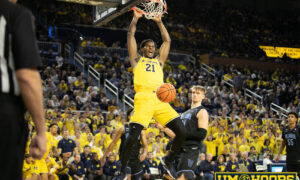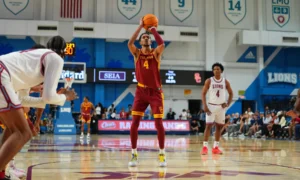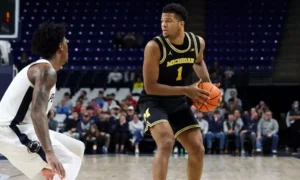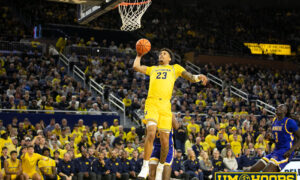 I’m on vacation for the long weekend, but this is the first of several guest posts from Alex Cook (@alexcook616) who put together an interesting similarity score system to analyze returning Michigan players. – Dylan
I’m on vacation for the long weekend, but this is the first of several guest posts from Alex Cook (@alexcook616) who put together an interesting similarity score system to analyze returning Michigan players. – Dylan
A big part of basketball analysis is comparative in nature, especially when it comes to individual players. Player “x” is better than player “y,” or “x” is reminiscent of “z,” it’s all a very common tool when evaluating a player’s game or his statistical output. Certain mannerisms and attributes make us think of former players – Tall, lanky Caris LeVert, his quick-release jumpshot and his mesmerizing handle hearken back to Jamal Crawford, for example – and sometimes, it’s a similar role that a player provides for his team – perhaps Trey Burke, consummate leader, scoring and assisting point guard, was simply a rich man’s Talor Battle (with a better supporting cast, of course)? Comparisons are fun for discussion, often instructive, and they do a great deal to define the players that we watch from November to April in the nation’s best conference.
Inspired by the similarity scores on KenPom and Basketball-Reference’s player profiles, I set out to develop a statistical system by which the statistical profiles of Big Ten players could be compared and evaluated by their level of similarity. Because of a lack of available formulas to base that system on – even the initial set of equations used by Bill James to compare baseball players isn’t readily found anywhere online – I devised my own way to gauge the similarity of players. Since the outputs for a given player seemed intuitively correct, I ran with the formula and used it on a sample of seven Big Ten seasons, with all of the players on kenpom’s team profiles included (save for a few who played too few games).
If you’re statistically inclined and want to know more about how this was accomplished, click here. Otherwise, we’ll start with Caris LeVert.
Following Michigan’s run to the Final Four in 2013, Trey Burke and Tim Hardaway took their talents to the NBA and Michigan found itself with a minutes and usage vacuum in the backcourt. Caris LeVert, a skinny reserve wingman, was slotted in for big minutes at the two-guard, but besides his remarkable two-dimensional existence, he was a complete unknown. With some extra scholarships available, John Beilein took a flier on LeVert at the end of the 2012 recruiting cycle (though other Big Ten programs showed attention), and last year it paid big dividends.
The comparison that immediately jumps off of the page: Tim Hardaway, Jr.’s junior season (2013). LeVert essentially replaced Hardaway’s season with an eerily similar statistical profile – Caris was more efficient, though on fewer possessions, and was better at both getting to the free throw line and distributing the ball than Tim was. The margins everywhere were pretty thin, but I’d say that LeVert’s 2014 was slightly better than Hardaway’s 2013: pretty much the best-case scenario for Michigan. For Tim, going to the NBA proved to be the correct choice, but the Wolverines didn’t miss a beat without him.
Other comparable seasons are quite encouraging. Hardaway and Ohio State’s William Buford each show up twice – neither were ever the go-to scorer or facilitator for their teams, but both were quite good complementary scorers on the wing for some great teams. LeVert had a somewhat lesser role than either did in the four seasons listed, but he was a better shooter than they were in any of those seasons. Stanley Pringle was an undersized two-guard next to Talor Battle for Penn State, and the core of Battle, Pringle and Jamelle Cornley was good enough to carry a pretty decent PSU team to an NIT title (and the ceremonial title of 66th-best team in the country). Kevin Coble and Drew Crawford both held the torch offensively for some doomed Bill Carmody Northwestern teams; they were wings that managed to effectively blend usage and efficiency well, but never enough to make up for Carmody’s inevitably terrible defenses.
Freshmen E’Twaun Moore – part of the trio of “Baby Boilers” along with Robbie Hummel and JaJuan Johnson that led Purdue to four consecutive top-three finishes in the Big Ten – and Matt Gatens – a bright spot on some mostly bad Iowa teams – are interesting: both put together excellent four-year careers (Moore parlayed his into an NBA career and currently plays with Victor Oladipo in Orlando) and had great freshman seasons, but regressed as sophomores under the burden of a higher usage rate. These freshman years could theoretically be regarded as potential indicators as to how much LeVert’s numbers may improve next year, but both Moore and Gatens were worse across the board. Below, I charted the usage versus efficiency of players similar to LeVert with an eye towards the numbers they posted the next year.**
The common thread is that with an increase in usage, there is a corresponding decrease in efficiency. Jordan Crawford stands out as the lone exception, but the baseline season (2008 Indiana) happened before his transfer to Xavier (2010), which was in the much weaker Atlantic-10 Conference. Ben Brust, who has high efficiency but low usage, is somewhat of an outlier in this sample as well. Otherwise, it’s not looking good for LeVert – he’s expected to bump up his usage a few notches with the vacuum left by Glenn Robinson and especially Nik Stauskas – as Moore and Gatens, when faced with similar situations, saw precipitous drop-offs in efficiency. Both players had higher turnover rates the next season, and both saw fairly sizeable decreases in true shooting percentage.
For those reasons, the E’Twaun Moore and Matt Gatens comparisons – though they indicate that Caris LeVert is on track to have a very good Big Ten career – may suggest that his efficiency will plummet a bit as he assumes more offensive responsibility. Still, on the whole, I think these comparisons are rather favorable. LeVert made a massive improvement over the last offseason, and went from a situational end-of-the-rotation guy to a key cog in the best offense in the 14 years that kenpom has tracked. His comparables suggest this context: in 2013, Caris was a very good wing (or specifically, a very good two-guard) who wasn’t the go-to guy but still blended efficiency with a nice all-around game.
**The top ten players who played another year after their comparable seasons: Moore (similarity rank: 1), Gatens (3), Buford (5), Hardaway (7), Crawford (9), Buford again (11), Jordan Crawford (14), Moore again (22), Gatens again (23), and Ben Brust (25). The points connected in sets of three are the seasons logged by Moore, Gatens and Buford, with the blue point as the first year, the purple as the second, and the red as the third.
Alex Cook, the author of this post, can be found on Twitter @alexcook616. Any comparison requests are more than welcome.











